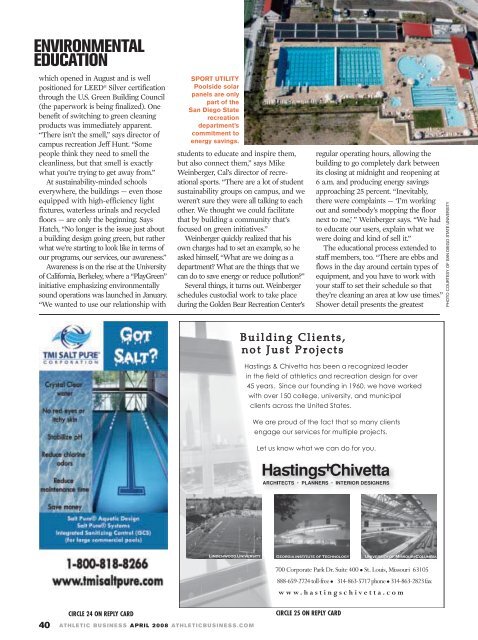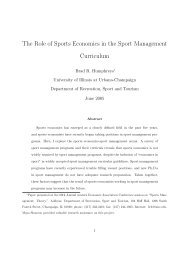Environmental Education
Environmental Education
Environmental Education
You also want an ePaper? Increase the reach of your titles
YUMPU automatically turns print PDFs into web optimized ePapers that Google loves.
ENVIRONMENTAL<br />
EDUCATION<br />
which opened in August and is well<br />
positioned for LEED® Silver certification<br />
through the U.S. Green Building Council<br />
(the paperwork is being finalized). One<br />
benefit of switching to green cleaning<br />
products was immediately apparent.<br />
“There isn’t the smell,” says director of<br />
campus recreation Jeff Hunt. “Some<br />
people think they need to smell the<br />
cleanliness, but that smell is exactly<br />
what you’re trying to get away from.”<br />
At sustainability-minded schools<br />
everywhere, the buildings — even those<br />
equipped with high-efficiency light<br />
fixtures, waterless urinals and recycled<br />
floors — are only the beginning. Says<br />
Hatch, “No longer is the issue just about<br />
a building design going green, but rather<br />
what we’re starting to look like in terms of<br />
our programs, our services, our awareness.”<br />
Awareness is on the rise at the University<br />
of California, Berkeley, where a “PlayGreen”<br />
initiative emphasizing environmentally<br />
sound operations was launched in January.<br />
“We wanted to use our relationship with<br />
SPORT UTILITY<br />
Poolside solar<br />
panels are only<br />
part of the<br />
San Diego State<br />
recreation<br />
department’s<br />
commitment to<br />
energy savings.<br />
students to educate and inspire them,<br />
but also connect them,” says Mike<br />
Weinberger, Cal’s director of recreational<br />
sports. “There are a lot of student<br />
sustainability groups on campus, and we<br />
weren’t sure they were all talking to each<br />
other. We thought we could facilitate<br />
that by building a community that’s<br />
focused on green initiatives.”<br />
Weinberger quickly realized that his<br />
own charges had to set an example, so he<br />
asked himself, “What are we doing as a<br />
department? What are the things that we<br />
can do to save energy or reduce pollution?”<br />
Several things, it turns out. Weinberger<br />
schedules custodial work to take place<br />
during the Golden Bear Recreation Center’s<br />
Lindenwood University<br />
CIRCLE 24 ON REPLY CARD<br />
40 ATHLETIC BUSINESS APRIL 2008 ATHLETICBUSINESS.COM<br />
Building Clients,<br />
not Just Projects<br />
CIRCLE 25 ON REPLY CARD<br />
regular operating hours, allowing the<br />
building to go completely dark between<br />
its closing at midnight and reopening at<br />
6 a.m. and producing energy savings<br />
approaching 25 percent. “Inevitably,<br />
there were complaints — ‘I’m working<br />
out and somebody’s mopping the floor<br />
next to me,’ ” Weinberger says. “We had<br />
to educate our users, explain what we<br />
were doing and kind of sell it.”<br />
The educational process extended to<br />
staff members, too. “There are ebbs and<br />
flows in the day around certain types of<br />
equipment, and you have to work with<br />
your staff to set their schedule so that<br />
they’re cleaning an area at low use times.”<br />
Shower detail presents the greatest<br />
Hastings & Chivetta has been a recognized leader<br />
<br />
45 years. <br />
<br />
clients across the United States.<br />
<br />
<br />
<br />
Georgia institute of Technology University of Missouri-Columbia<br />
700 Corporate Park Dr. Suite 400 St. Louis, Missouri 63105<br />
888-659-2724 toll-free 314-863-5717 phone 314-863-2823 fax<br />
www.hastingschivetta.com<br />
PHOTO COURTESY OF SAN DIEGO STATE UNIVERSITY
















